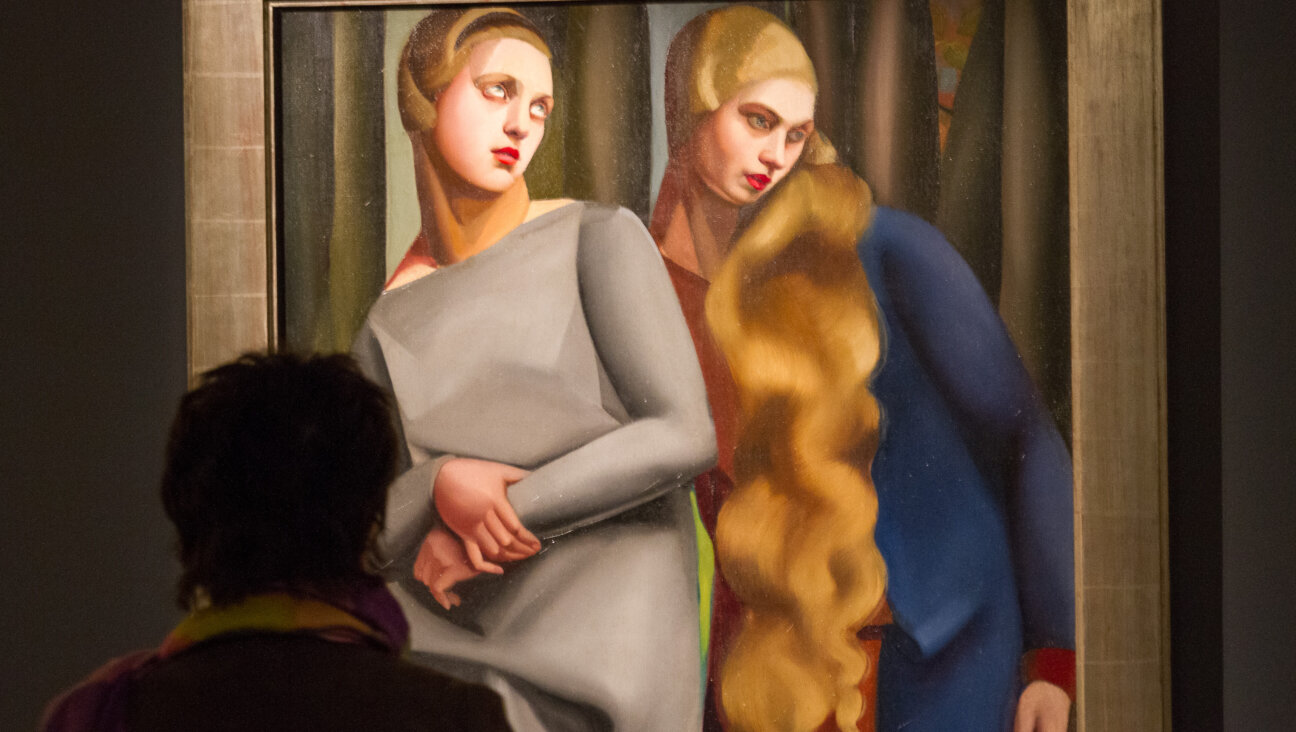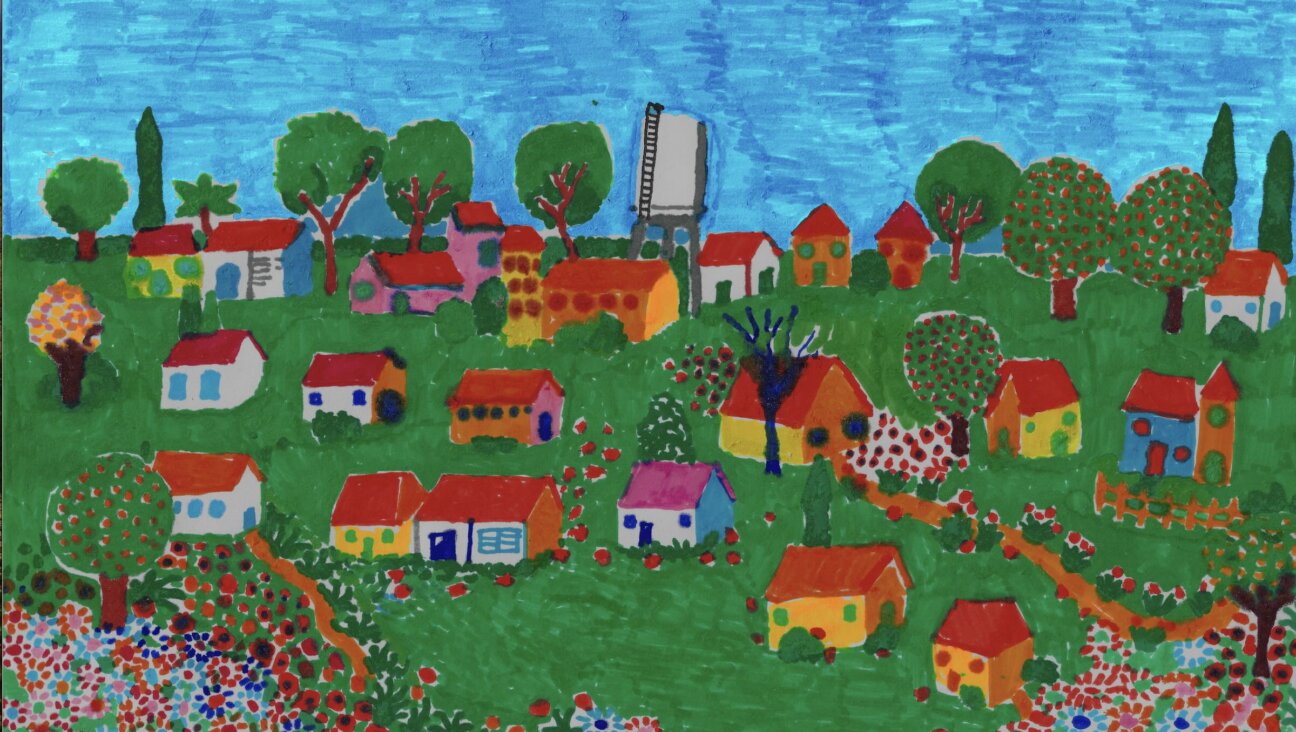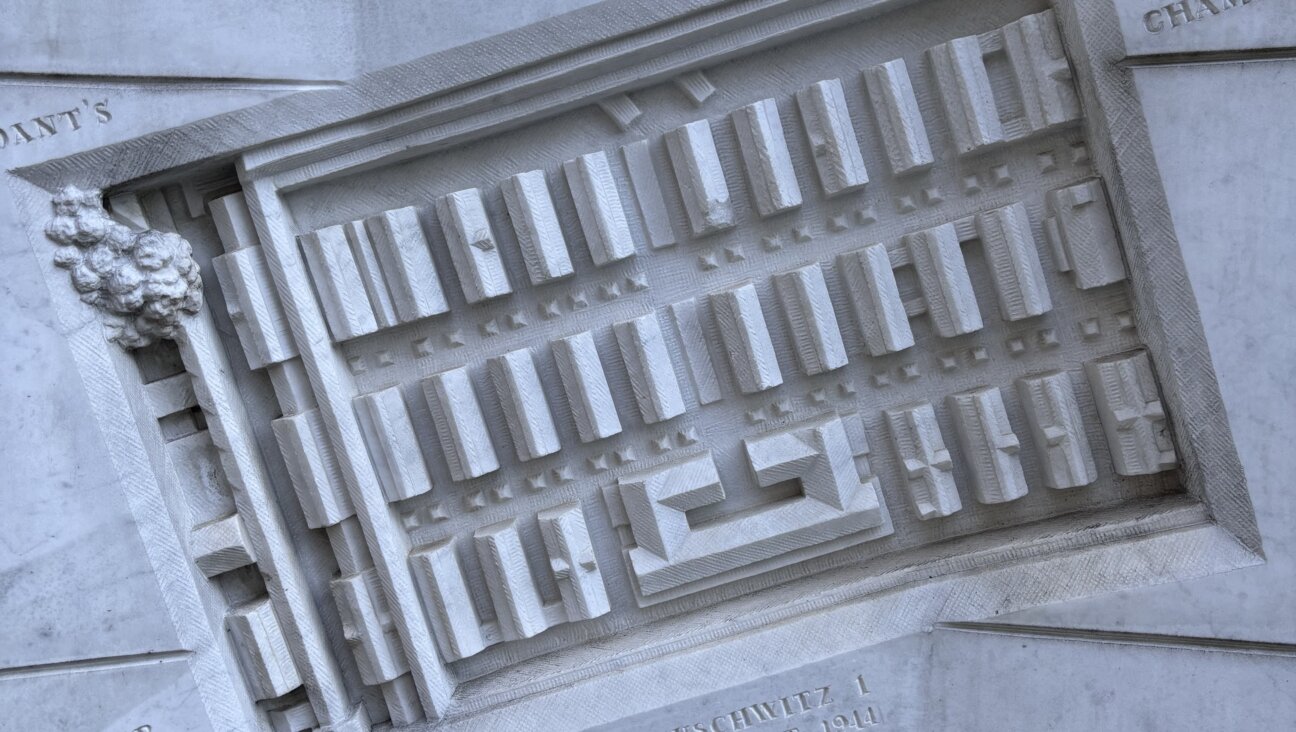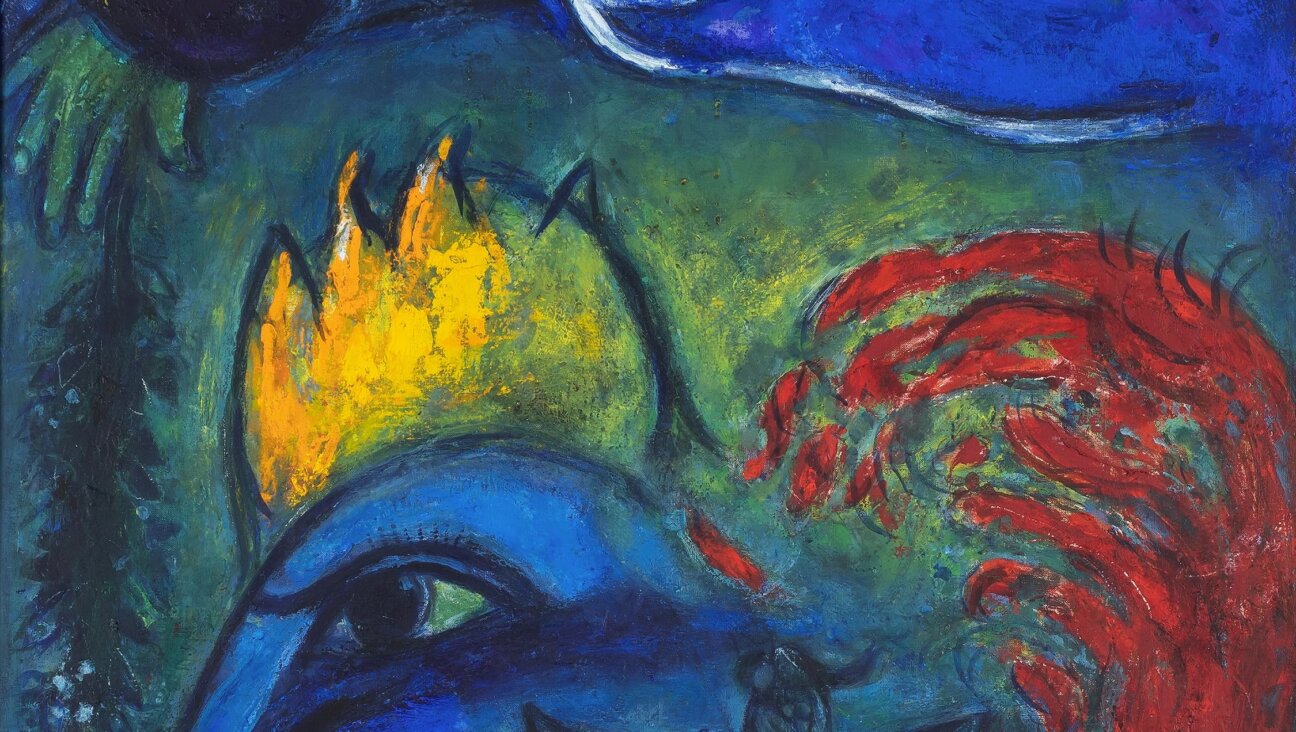Crossing Borders in Palestinian Contemporary Art

Image by Umm-el-Fahem Gallery
The Umm el-Fahem Gallery, dedicated to exhibiting contemporary Palestinian and Arab art, contains an archive seemingly at odds with its mission. It features the photographs and life histories of some 300 of the town’s oldest inhabitants, most of them already dead.
But these stories were sacred to the Gallery’s founder and director, Said Abu Shakra, who viewed archiving them as a way to honor the history of this ancient village, as well as to revive and preserve the memories of the town’s residents after the displacement of 1948. It was also a way to make the Gallery — and the art it exhibits — relevant to Umm el-Fahem’s citizens.
Part gallery, part social service center, the Umm el-Fahem Gallery, established in 1996 in this gritty but vibrant town in the heart of northern Israel’s Arab Wadi Ara region, is committed to improving the lives of its 50,000 residents, some 60% of whom live in poverty. This fact greatly complicates but also defines Abu Shakra’s mission, and marries his curatorial and community work.
Abu Shakra’s sense of purpose began to take shape in 1999 when, scoring a gallery director’s dream, he landed an exhibit by Yoko Ono. Thousands of people showed up, and Abu Shakra invited one of his neighbors to attend. Standing on the threshold, gazing at the well-dressed throngs, the neighbor quietly edged away saying, “This will be for my children, not me. I’m poor.” At this moment, Abu Shakra realized that he had to work for these 60% “who live in the alleyways, the cafes, the streets, the ones who feel invisible, to make them realize that I see them.” He felt his calling was “to build trust, empathy, love.”
These are startling words to hear from a former police officer. Abu Shakra spent seven years investigating fellow officers suspected of corruption and violence against Arabs, and heading up a juvenile crime unit. But he’s also one of three brothers, all of whom studied art. His older brother, Walid Abu Shakra, an etcher in London, and his younger one, Farid Abu Shakra, a painter and woodworker, are internationally successful artists whose works are part of the Gallery’s impressive permanent collection of almost 400 paintings, drawings, sculptures and videos by Jewish and Arab artists.
What prompted Said Abu Shakra’s dramatic career change was the tragic death from cancer of a cousin, Asim Abu Shakra, in 1990 at the age of 29. Asim Abu Shakra was a rising star among Jewish and Palestinian Israeli artists. When the Helene Rubenstein Pavilion in the Tel Aviv Museum of Art mounted an exhibition of his work in 1994, Said Abu Shakra was shocked to realize that the exhibit catalogue did not contain a single commentary from an Arab artist. They were not intentionally excluded, he hastens to add, but could not contribute because, he believed, they had no language with which to express themselves.
To get ahead, Palestinian Israelis had encouraged their children to study medicine, engineering, law, accounting and pharmacology, not art. When Asim Abu Shakra became a famous artist, there was no native vocabulary with which to describe his kind of success. “We were like a vessel that had been moved from place to place,” recalled Said Abu Shakra. “If we wanted to return pride to Palestinians living in Israel we had to research, assemble, restore and exhibit our own culture. I wanted to stop relating to myself as a victim and become a person who takes responsibility for guiding my culture to a better place.”

Image by Umm El-Fahem Gallery
Art is a plant that would not be expected to thrive in the soil of Umm el-Fahem. It is a figurative medium in an Islamist community that shuns representative art. So Abu Shakra — who is traditional but not strictly observant — does not serve alcohol at openings, nor does he exhibit works of nudity out of respect for religious strictures. Since the local Islamists do not tolerate self-critical political art, it is passed over by the curators.
Art is also a luxury commodity for a poor town. Abu Shakara has looked for ways to make the community realize that they are stakeholders in his gallery’s success.
In 2012, to celebrate 800 years of Umm el-Fahem, Abu Shakra and his curatorial staff decided to renovate a number of houses around the town, including some that had been abandoned to local drug addicts, to use as exhibition spaces for work by both Palestinian and Jewish Israeli artists. Minivans transported viewers from the Gallery to these scattered sites. The idea was to break down the barrier of fear and reluctance that most Jewish Israelis have when visiting Arab towns and homes, to get them to “look in the eye” of the other.
But he worried that as these homes sat idle, they would be vandalized by local youths. So Abu Shakra had the kids help with the renovations and told them to go home and have their families prepare food to sell to the visitors. He then urged the visitors to buy the wares from the locals. Ultimately, the surrounding neighborhoods were cleaned of graffiti, and the sidewalks swept in eager anticipation of commerce.
Though committed to breaking down barriers that separate Jewish from Palestinian Israelis, Abu Shakra is careful not to call what he works for “coexistence.” He prefers the term “partnership” which implies that there is still work to be done. One might speculate that his stance is informed by the views of Umm el-Fahem’s Islamists, who reject coexistence on the grounds that it implies a acceptance of Israel.
But there is also genuine heat when I ask Abu Shakra about former Foreign Minister Avigdor Lieberman’s insistence last year, during the peace talks between Israel and the Palestinian Authority, that his support of any agreement would be contingent on sliding Israel’s future eastern border westward, automatically shifting citizenship for all the overwhelmingly Arab inhabitants of the larger Wadi Ara area from Israel to a new Palestinian state. Like the vast majority of the town’s residents, Abu Shakra categorically rejects the maneuver.

Image by Umm El-Fahem Gallery
“Lieberman’s motives are bad. He just wants to further weaken the Arab minority in Israel, to separate us again from our families,” says Abu Shakra, sharply. “I have a daughter in Rehovot, and relatives all over Israel. If Lieberman wanted to bring real peace with open borders so we could travel anywhere, then great, I’m for it. But he doesn’t. It’ll be a new trauma.”
Despite the Gallery’s commitment to showcasing local talent, the self-censorship that comes from respecting local religious and political mores means that exhibition quality is uneven. Yet creative solutions sometimes are found. Druze artist Asad Azi, for example, allowed his current exhibit to be split between the Umm el-Fahem Gallery and the kibbutz-based Ein Harod Museum, 32 km to its east. Works that deal with erotica and political self-critique will be featured at Ein Harod.
Despite its limitations, CNN ranked the Umm el-Fahem Gallery as the country’s sixth best museum. It has been the subject of an article in The New York Times, and Israel’s international art darling, Michal Rovner, has donated a piece to the Gallery.
Still, the gallery struggles to maintain its modest exhibit space — a rented, unprepossessing former office building of approximately 1,000 square meters. Tax exempt and supported by grants from Israel’s National Lottery and the Ministry of Culture, the Gallery relies on private donations to make up for shortfalls; needs are prioritized.
The installation of air-conditioning for the rooms housing the permanent collection has been postponed. More painfully, the dream of erecting Israel’s first Museum of Arab and Palestinian Contemporary Art by moving the Gallery to the grounds of a 15,000-square-meter permanent museum has been indefinitely deferred.
The Umm el-Fahem municipality donated a parcel of land at the town’s entrance, and an architectural competition produced a winner in 2008, but the plans sit idle; there are simply no funds in place. Abu Shakra appealed to wealthy Arab donors, hoping they would provide about 40% of the money, but many have refused to donate to a project on Israeli territory, let alone one that receives Israeli state funding.
On the day I visited in June, the stalled dream had become tinged with bitterness. That morning an article in Haaretz had appeared with the sub-headline, “Is the Umm el-Fahem Museum or the Arab Museum of Contemporary Art in Sakhnin the first Arab museum in Israel?”
Two Jewish Israelis had launched the new museum in the Arab Israeli town of Sakhnnin the week before. Abu Shakra was indignant, regarding them as upstarts with no organic ties to Sahknin, whose venture was bound to fail.
Though the success of the Sakhnin venture remains to be seen, Abu Shakra and Ruth Oppenheim, Umm el-Fahem Gallery’s bright, energetic young director of external relations, are proud of what the Umm el-Fahem Gallery has accomplished up to now.
As she led me on a tour of the building, Oppenheim showed me the Gallery’s shabby but busy warren of rooms.
The upstairs houses a ceramics studio run by Rina Peleg, a Jewish Israeli who teaches the craft to groups of local Palestinian Israeli women, aged 20 to 60. Most have no previous crafts experience and have only heard stories from their grandmothers about the tradition. Almost all the women wear the hijab and are not permitted to work outside their homes. They are allowed to come to the Gallery, though, because Abu Shakra is known and trusted.
Another set of rooms is for after-school art lessons for children from K-18, and for kids at risk. A third area is being renovated to host an artist-in-residence program that will allow a resident to conduct a month-long, site-specific project engaging the community directly in his or her work.
This kind of dynamic choreography between the artists and the village, between the Gallery and the people it serves is what Abu Shakra regards as the proper role for the arts in a poor community.
The winning plan for the Umm el-Fahem Museum of Contemporary Art envisions a building whose lower floors, planted into the wadi, will house the Museum’s archive of native life stories and serve as its foundation, both literal and metaphoric. Above will soar the gallery space, covered in delicate latticework comprised of Arabic calligraphy. It will trace a love poem by Egyptian poet, Abdel Rahman Shokry, letting the light stream in.
But for now it remains on the drawing board.
Filmmaker Toby Perl Freilich directed “Inventing Our Life: The Kibbutz Experiment.” She is currently co-directing a documentary about the late U.S. Senator Daniel Patrick Moynihan.
A message from our Publisher & CEO Rachel Fishman Feddersen

I hope you appreciated this article. Before you go, I’d like to ask you to please support the Forward’s award-winning, nonprofit journalism so that we can be prepared for whatever news 2025 brings.
At a time when other newsrooms are closing or cutting back, the Forward has removed its paywall and invested additional resources to report on the ground from Israel and around the U.S. on the impact of the war, rising antisemitism and polarized discourse.
Readers like you make it all possible. Support our work by becoming a Forward Member and connect with our journalism and your community.
— Rachel Fishman Feddersen, Publisher and CEO























